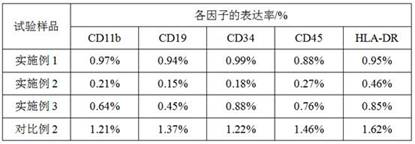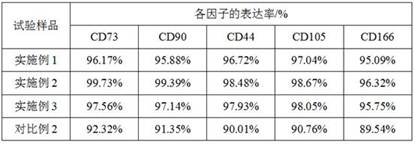Culture method and application of primary amniotic stem cells
A culture method and stem cell technology, which is applied to animal cells, embryonic cells, vertebrate cells, etc., can solve the problems of low cell purity, difficulty in cell attachment, and complicated removal, so as to accelerate cell attachment, shorten culture time, and improve cell The effect of improving the purity
- Summary
- Abstract
- Description
- Claims
- Application Information
AI Technical Summary
Problems solved by technology
Method used
Image
Examples
Embodiment 1
[0026] Example 1 A method for culturing primary amniotic stem cells
[0027] The culture method of the primary amniotic stem cells, the preparation process is as follows:
[0028] S1. Under sterile conditions, the amniotic membrane was peeled off from the placenta, washed three times with normal saline to remove blood capillaries and viscous substances on the amniotic membrane, and then cut into 6cm×6cm tissue pieces in a petri dish. Place the smooth side down to obtain a preliminarily processed amniotic tissue block;
[0029] S2. Place the preliminarily processed amniotic tissue pieces obtained in step S1 in a 90mm petri dish, place a small piece of tissue in each petri dish, and then mix trypsin, chymosin and xylanase in a weight ratio of 8: Mix well in a ratio of 2:1 to prepare digestive enzymes, add the digestive enzymes to each petri dish, place them at 23 °C for 28 min at an added amount of 2.5 g / L, and then wash with normal saline twice to prepare Digested amniotic ti...
Embodiment 2
[0032] Example 2 A method for culturing primary amniotic stem cells
[0033] The culture method of the primary amniotic stem cells, the preparation process is as follows:
[0034] S1. Under sterile conditions, the amniotic membrane was peeled off from the placenta, washed 5 times with normal saline to remove blood capillaries and viscous substances on the amniotic membrane, and then cut into 6cm×6cm tissue pieces in a petri dish. Place the smooth side down to obtain a preliminarily processed amniotic tissue block;
[0035] S2. Place the preliminarily processed amniotic tissue pieces obtained in step S1 in a 90mm petri dish, place a small piece of tissue in each petri dish, and then mix trypsin, chymosin and xylanase in a weight ratio of 15: The digestive enzymes were mixed in a ratio of 4:3 to make digestive enzymes. The digestive enzymes were added to each petri dish, placed at 27 °C for 32 min at 2.5 g / L, and then washed 4 times with normal saline to prepare the digested en...
Embodiment 3
[0038] Example 3 A method for culturing primary amniotic stem cells
[0039] The culture method of the primary amniotic stem cells, the preparation process is as follows:
[0040] S1. Under sterile conditions, the amniotic membrane was peeled off from the placenta, washed 4 times with normal saline to remove blood capillaries and viscous substances on the amniotic membrane, and then cut into 6cm×6cm tissue pieces in a petri dish. Place the smooth side down to obtain a preliminarily processed amniotic tissue block;
[0041] S2. Place the preliminarily processed amniotic tissue pieces obtained in step S1 in a 90 mm petri dish, place a small piece of tissue in each petri dish, and then mix trypsin, chymosin and xylanase in a weight ratio of 12: The digestive enzymes were mixed in a ratio of 3:2 to make digestive enzymes. The digestive enzymes were added to each petri dish, placed at 25 °C for 30 min at 2.5 g / L, and then washed with physiological saline for 3 times. the amniotic...
PUM
 Login to View More
Login to View More Abstract
Description
Claims
Application Information
 Login to View More
Login to View More - R&D
- Intellectual Property
- Life Sciences
- Materials
- Tech Scout
- Unparalleled Data Quality
- Higher Quality Content
- 60% Fewer Hallucinations
Browse by: Latest US Patents, China's latest patents, Technical Efficacy Thesaurus, Application Domain, Technology Topic, Popular Technical Reports.
© 2025 PatSnap. All rights reserved.Legal|Privacy policy|Modern Slavery Act Transparency Statement|Sitemap|About US| Contact US: help@patsnap.com



